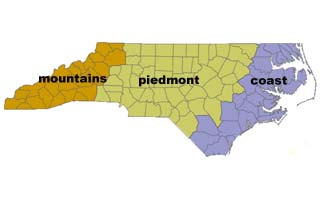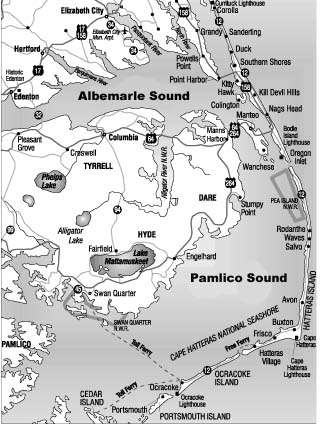Here is information about North Carolina's geography, commercial industries, and economy. This information can be helpful to give you an idea about NC, its resources, and its challenges.

North Carolina is one of the first thirteen colonies of the United States. It is bordered by Georgia and South Carolina to the south, Tennessee to the west, and Virginia to the north.
North Carolina's landscape can be divided into three distinct habitat-types, the mountains, piedmont, and coast. The Appalachian Mountains run through the western part of the state, which include the Blue Ridge Mountains and Great Smoky Mountains. The piedmont is high and mostly flat plateau. The coastal plain is distinguished by a series of barrier islands, known as the Outer Banks, that create the Albemarle and Pamlico Sounds. Together these sounds and the rivers that empty into them create the second largest estuarine ecosystem in the United States.
(www.visitnc.com/inside_nc/map_us.asp; www.secretary.state.nc.us/kidspg/geog.htm)
North Carolina's
economy was once dominated almost exclusively by tobacco, textile, and
furniture. There has been tremendous diversification over the years to
include tourism, recreation, poultry and hog farming, banking, and manufacturing
of chemicals, machinery, and computers. Research Triangle Park has brought
technology and pharmaceutical research, development, and manufacturing
to the state since 1959. Overall, the service and manufacturing sectors
remain two of the most vital areas of the state's economy. Manufacturing
makes up nearly a fourth of North Carolina's gross state product, i.e.
the total value of goods and services produced in the state in a year.
In addition, the amusement and recreation industry accounted for just
over $1.6 billion of the gross state product in 2000 and filmmaking contributed
nearly $200 million to the state's economy.
The top 10 industries in North Carolina for 2000.
- Finance, Insurance & Real Estate- $54.9 billion
- Government- $34.2 billion
- Retail Trade- $24.1 billion
- Transportation & Utilities- $18.7 billion
- Wholesale Trade- $16.6 billion
- Construction- $13.9 billion
- Health Services- $13.2 billion
- Chemicals- $11.4 billion
- Tobacco Products- $10.6 billion
- Agriculture,
Agricultural
Services, Forestry and Fishing- $9.9 billion
(www.secretary.state.nc.us/kidspg/econ.htm; www.infoplease.com/ce6/us/A0860030.html)
- CAPITAL:
Raleigh
- POPULATION:
(2001 estimate) 8,186,268
- AREA: 48,718 square miles
- RANK IN
POPULATION: 11th
- RANK IN
AREA :
29th
- LARGEST
COUNTY
- (Population):
Mecklenburg (716,407 people in 2001)
- (Area):
Robeson (948.9 square miles)
- (Population):
Mecklenburg (716,407 people in 2001)
- ENTERED
THE UNION:
November 21, 1789 (12th state)
- NICKNAME: The Old North State/ The Tarheel State

Fishing has had a long history in North Carolina's economy and coastal heritage. North Carolina's rich estuarine habitat has established it as one the top ten states in the nation in both recreational and commercial annual marine fish landings. North Carolina's marine fishery contributes approximately one billion dollars annually to the state's economy.
The more than 730 marine species in North Carolina’s estuarine and coastal communities makes it the second most diverse marine ecosystem in the East or Gulf coasts. North Carolina’s estuaries provide nutrients and shelter for some part of the life history of 95% of the commercial fish species caught in the state. The estuaries are an important fishing ground for North Carolina’s seafood industry, which harvests 39 major fish stocks and more than 100 million pounds of seafood annually.
Commercial fish landings provide a general assessment of the population status of the target species, however, these numbers alone do not give an indication of the health of fish stocks. Increased landings over time can be due to abundance of fish caught or simply an improvement in fishing techniques. Better equipment, larger fishing fleet and staff, and longer hours can lead to higher catches.
It is difficult to determine the actual population status of marine fisheries. Increased fish landings give the false impression of a healthy fishery if fishing equipment and fleet also increase. This is one important issue that the North Carolina fishing industry is currently facing. Is NC's fish and shellfish population declining?
(NC NERR, 2000; Ross and Bichy, 2002; NMFS 2003a; www.pepps.fsu.edu/segip/states/NC/natural.html; www.insiders.com/outerbanks/map-outerbanks.htm)

This web site was created by Lynn Tran at the North Carolina State University, Department of Mathematics, Science, and Technology Education on 7/12/03. Faculty advisor Dr. David Eggleston, NCSU, Department of Marine, Earth, & Atmospheric Sciences. Last updated December 29, 2003 .